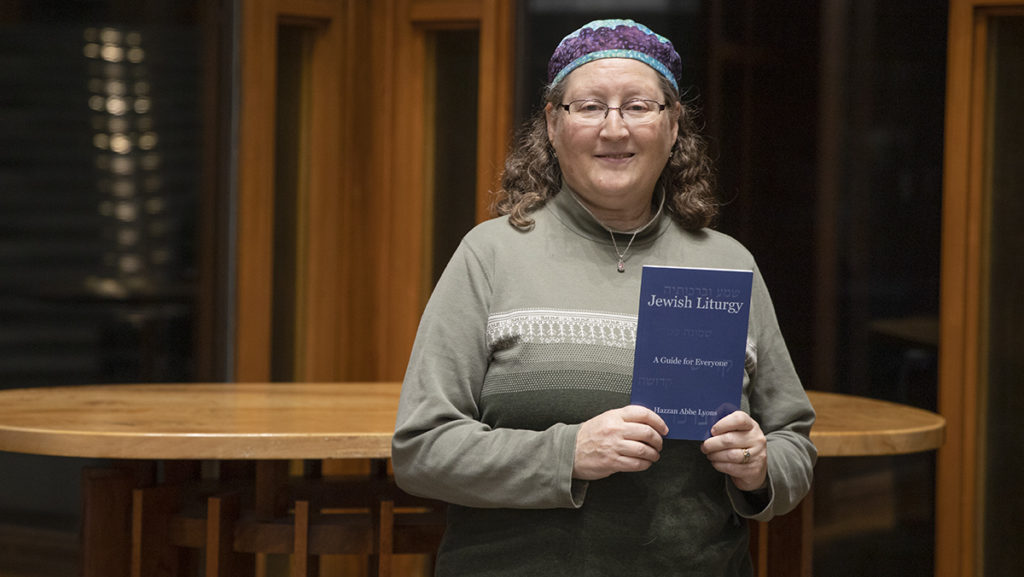Cantor Abbe Lyons ’87, college affiliate, released her new book, “Jewish Liturgy: A Guide for Everyone,” which discusses the observance of Judaism through engaging recitations and music, like those found in the Torah and Haftorah, Amidah, Piyyutim and the Psalms. The book was published Dec. 22, 2022. Lyons wrote the book to educate people with any level of knowledge who are interested in learning more about the Jewish faith.
Lyons graduated from the Ithaca College School of Music with a degree in voice performance. She came back as a Hillel at Ithaca College board member and later served as interim executive director in Spring 2010. She now divides her time between Hillel at Ithaca College and Hillel at Binghamton University and teaches Jewish liturgical music, Hebrew and prayer techniques and music theory to the ALEPH Faculty, which is a program that trains Jewish religious leaders.
Contributing writer Ashan Chandrasena sat down with Lyons to discuss the release of her new book and creating accessible religious education.
This article has been edited for length and clarity.
Ashan Chandrasena: What inspired the idea for this book?
Abbe Lyons: Well, actually, when I was in cantorial school, my final semester, the director of the cantorial program and I were having a conversation, and he encouraged me to write something for laypeople on Jewish liturgy based on all that I had learned because he saw that I was able to get excited about it and able to talk about it in an accessible way. So I did it like a capstone project, even though we didn’t have capstone projects formally at that point in the program. And I wrote it, but then it sat around for a long time. Then over the years, I began to teach because I used to work at the Congregation Tikkun V’or or the Reform Synagogue of Ithaca. I was teaching the middle schoolers there and developed some curriculum materials for teaching them about liturgy. And I also did a liturgy play shop at the Aleph Kallah, which is a bi-annual retreat for adults. So I kept sort of developing related material. And a couple of years ago, I realized that I really should get this work out there because it would be helpful for people. So I began combining those things into my original project and editing it. Through the help of my colleague Rabbi Oren Steinitz, I was able to publish it through his Hamotzi press and get it on Amazon.
AC: What would you say a significant change has been from the first draft to the final manuscript that went out for publication?
AL: When I first wrote the manuscript I asked some friends who had some knowledge, but were still laypeople, to read over the manuscript, to see if it was in fact accessible and help demystify some things about Jewish liturgy, which was the whole purpose of writing [the book]. And they gave me some suggestions. Most importantly, they asked me to add a glossary to define terms that I was using, some of which they knew and some of which they didn’t know. I also added infographics and charts that came out of the curriculum work that I did.
AC: What would you say the most challenging part about writing this book was?
AL: I’d say the most challenging part was getting myself through that last lap and saying, “I’ve got to do what it takes to get it out there.” Just moving into that phase was the hardest thing. But I did have the encouragement of … a writer’s circle. And that really made a difference for me and I was able to get over that hump.
AC: Who in particular are you hoping reads this book?
AL: Anybody who wants to get some insight into what we do at Jewish services, and why, is my target audience. I did a book talk at a conference recently, and I was asked by a lot of people if it was appropriate for B’nai Mitzvah students, for middle schoolers, and I think it’s better for high school and up because I’m talking about history and middle schoolers are just beginning to study history and get a sense of that. So they don’t have as much to plug into it. But it’s inspired me to create some curriculum, [to] publish some of my curriculum and study guides to go along with the book. That’s the project I didn’t know I was going to be doing, but people are asking for it.
AC: What message are you hoping they take away from it?
AL: I’m hoping that they get a sense of the amazing creativity that has gone into the liturgy that contains the continuing development that is happening. I think my final two sentences in the book sum up my message: “We have a treasure trove of Jewish liturgical creativity. The Jewish people are still inspired to continue and preserve our conversations with and about God.”








